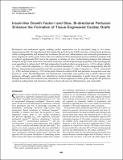Insulin-like Growth Factor-I and Slow, Bi-directional Perfusion Enhance the Formation of Tissue-Engineered Cardiac Grafts
Author(s)
Cheng, Mingyu; Moretti, Matteo; Engelmayr, George C.; Freed, Lisa E.
DownloadCheng-2009-Insulin-like Growth.pdf (597.4Kb)
PUBLISHER_POLICY
Publisher Policy
Article is made available in accordance with the publisher's policy and may be subject to US copyright law. Please refer to the publisher's site for terms of use.
Terms of use
Metadata
Show full item recordAbstract
Biochemical and mechanical signals enabling cardiac regeneration can be elucidated using in vitro tissue-engineering models. We hypothesized that insulin-like growth factor-I (IGF) and slow, bi-directional perfusion could act independently and interactively to enhance the survival, differentiation, and contractile performance of tissue-engineered cardiac grafts. Heart cells were cultured on three-dimensional porous scaffolds in medium with or without supplemental IGF and in the presence or absence of slow, bi-directional perfusion that enhanced transport and provided shear stress. Structural, molecular, and electrophysiologic properties of the resulting grafts were quantified on culture day 8. IGF had independent, beneficial effects on apoptosis (p < 0.01), cellular viability (p < 0.01), contractile amplitude (p < 0.01), and excitation threshold (p < 0.01). Perfusion independently affected the four aforementioned parameters and also increased amounts of cardiac troponin-I (p < 0.01), connexin-43 (p < 0.05), and total protein (p < 0.01) in the grafts. Interactive effects of IGF and perfusion on apoptosis were also present (p < 0.01). Myofibrillogenesis and spontaneous contractility were present only in grafts cultured with perfusion, although contractility was inducible by electrical field stimulation of grafts from all groups. Our findings demonstrate that multi-factorial stimulation of tissue-engineered cardiac grafts using IGF and perfusion resulted in independent and interactive effects on heart cell survival, differentiation, and contractility.
Date issued
2008-08Department
Harvard University--MIT Division of Health Sciences and TechnologyJournal
Tissue Engineering. Part A
Publisher
Mary Ann Liebert, Inc.
Citation
Cheng, Mingyu et al. “Insulin-like Growth Factor-I and Slow, Bi-directional Perfusion Enhance the Formation of Tissue-Engineered Cardiac Grafts.” Tissue Engineering Part A 15.3 (2009): 645-653. ©2009 Mary Ann Liebert, Inc.
Version: Final published version
ISSN
1937-3341
1937-335X